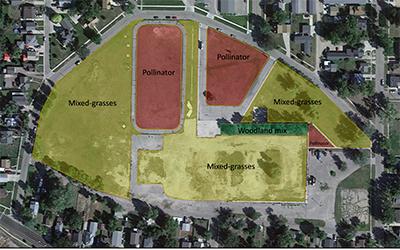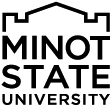Phase one set to begin on Plum River Native Prairie project

MINOT, N.D. – Minot State University, in conjunction with Minot Public Schools and Audubon Great Plains, will begin to bring the former Erik Ramstad Middle School site back to life with an exciting urban prairie restoration.
The first phase to restore the 14-acre stretch of property to a native mixed-grass prairie is set to begin before the end of October. The site will be named Plum River Native Prairie, which serves to honor both the ecological and Indigenous perspectives for the project, and will provide a variety of environmental, educational, economic, aesthetic, and social benefits.
“We are very excited to get under way on a project that will provide a unique space for people to interact with a native prairie ecosystem in an urban setting,” said Chad Williamson, MSU assistant professor of wildlife ecology. “This ecological restoration project will not only increase native biodiversity and rare species but promote social well-being and experiential education opportunities for the greater Minot community.”
Although the area currently resembles a mowed field with a few overgrown parking lots, residents may notice heavy equipment arriving on the site within the next few weeks as ground tilling kicks off the first phase. Gooseneck Implement has graciously agreed to provide the equipment that will be used to break up the current vegetation and soils at no cost to the project.
“We are thrilled and filled with anticipation as we prepare to literally break ground on the Plum River Native Prairie project,” said Dan Conn, MSU associate professor and chair, teacher education and kinesiology. “We extend our heartfelt gratitude to Gooseneck Implement for their incredible generosity in lending both their equipment and expertise to this endeavor. With this support, we are now embarking on the exciting journey of transforming 14 acres of land into a living and informative learning space for individuals of all ages throughout the Minot community and beyond.”
Next spring and summer, the site will be treated with herbicides and additional tilling to prepare for seeding next fall. Site plans include maintaining the existing walking track, sidewalks, and parking areas for local residents and visitors. Residents should expect the project to take several years before the site begins to resemble a native prairie with specific areas designated for mixed-grass and wildflower species. When mature, the site will provide habitat for a variety of birds, mammals, reptiles, amphibians, and insects that may not currently be found in the city.
Stay tuned or additional updates and public events that relate to this unique project for Minot. Questions or concerns may be addressed to Minot State professors Conn (701-858-3267, daniel.conn@MinotStateU.edu) and Williamson (810-869-9960, chad.williamson@MinotStateU.edu).
About Minot State University
Minot State University is a public university dedicated to excellence in education, scholarship, and community engagement achieved through
rigorous academic experiences, active learning environments, commitment to public service, and a vibrant campus life.
Published: 10/20/23




